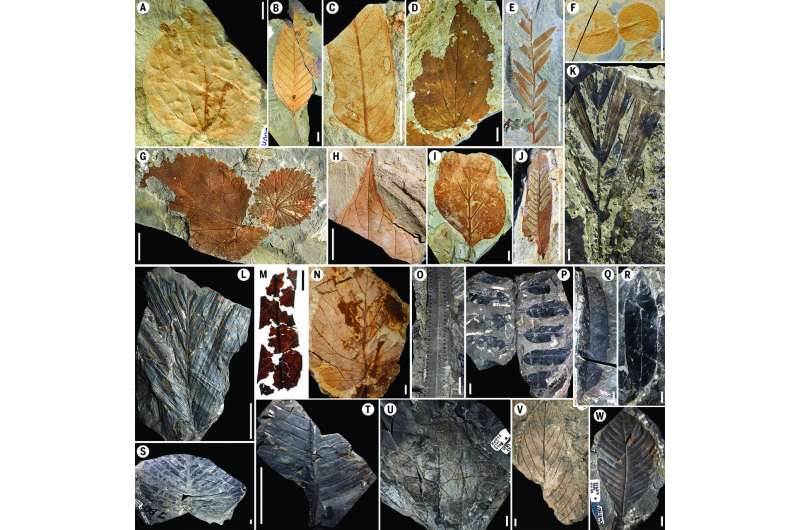How the Chicxulub impactor gave rise to modern rainforests

Tropical rainforests today are biodiversity hotspots and play an important role in the world's climate systems. A new study published today in Science sheds light on the origins of modern rainforests and may help scientists understand how rainforests will respond to a rapidly changing climate in the future.
The study led by researchers at the Smithsonian Tropical Research Institute (STRI) shows that the asteroid impact that ended the reign of dinosaurs 66 million years ago also caused 45% of plants in what is now Colombia to go extinct, and it made way for the reign of flowering plants in modern tropical rainforests.
"We wondered how tropical rainforests changed after a drastic ecological perturbation such as the Chicxulub impact, so we looked for tropical plant fossils," said Mónica Carvalho, first author and joint postdoctoral fellow at STRI and at the Universidad del Rosario in Colombia. "Our team examined over 50,000 fossil pollen records and more than 6,000 leaf fossils from before and after the impact."
In Central and South America, geologists hustle to find fossils exposed by road cuts and mines before heavy rains wash them away and the jungle hides them again. Before this study, little was known about the effect of this extinction on the evolution of flowering plants that now dominate the American tropics.
Carlos Jaramillo, staff paleontologist at STRI and his team, mostly STRI fellows—many of them from Colombia—studied pollen grains from 39 sites that include rock outcrops and cores drilled for oil exploration in Colombia, to paint a big, regional picture of forests before and after the impact. Pollen and spores obtained from rocks older than the impact show that rainforests were equally dominated by ferns and flowering plants. Conifers, such as relatives of the of the Kauri pine and Norfolk Island pine, sold in supermarkets at Christmas time (Araucariaceae), were common and cast their shadows over dinosaur trails. After the impact, conifers disappeared almost completely from the New World tropics, and flowering plants took over. Plant diversity did not recover for around 10 million years after the impact.
Leaf fossils told the team much about the past climate and local environment. Carvalho and Fabiany Herrera, postdoctoral research associate at the Negaunee Institute for Conservation Science and Action at the Chicago Botanic Garden, led the study of over 6,000 specimens. Working with Scott Wing at the Smithsonian's National Museum of Natural History and others, the team found evidence that pre-impact tropical forest trees were spaced far apart, allowing light to reach the forest floor. Within 10 million years post-impact, some tropical forests were dense, like those of today, where leaves of trees and vines cast deep shade on the smaller trees, bushes and herbaceous plants below. The sparser canopies of the pre-impact forests, with fewer flowering plants, would have moved less soil water into the atmosphere than did those that grew up in the millions of years afterward.
"It was just as rainy back in the Cretaceous, but the forests worked differently." Carvalho said.
The team found no evidence of legume trees before the extinction event, but afterward there was a great diversity and abundance of legume leaves and pods. Today, legumes are a dominant family in tropical rainforests, and through associations with bacteria, take nitrogen from the air and turn it into fertilizer for the soil. The rise of legumes would have dramatically affected the nitrogen cycle.

Carvalho also worked with Conrad Labandeira at the Smithsonian's National Museum of Natural History to study insect damage on the leaf fossils.
"Insect damage on plants can reveal in the microcosm of a single leaf or the expanse of a plant community, the base of the trophic structure in a tropical forest," Labandeira said. "The energy residing in the mass of plant tissues that is transmitted up the food chain—ultimately to the boas, eagles and jaguars—starts with the insects that skeletonize, chew, pierce and suck, mine, gall and bore through plant tissues. The evidence for this consumer food chain begins with all the diverse, intensive and fascinating ways that insects consume plants."
"Before the impact, we see that different types of plants have different damage: feeding was host-specific," Carvalho said. "After the impact, we find the same kinds of damage on almost every plant, meaning that feeding was much more generalistic."
How did the after effects of the impact transform sparse, conifer-rich tropical forests of the dinosaur age into the rainforests of today—towering trees dotted with yellow, purple and pink blossoms, dripping with orchids? Based on evidence from both pollen and leaves, the team proposes three explanations for the change, all of which may be correct. One idea is that dinosaurs kept pre-impact forests open by feeding and moving through the landscape. A second explanation is that falling ash from the impact enriched soils throughout the tropics, giving an advantage to the faster-growing flowering plants. The third explanation is that preferential extinction of conifer species created an opportunity for flowering plants to take over the tropics.
"Our study follows a simple question: How do tropical rainforests evolve?" Carvalho said. "The lesson learned here is that under rapid disturbances—geologically speaking—tropical ecosystems do not just bounce back; they are replaced, and the process takes a really long time."
More information: M.R. Carvalho el al., "Extinction at the end-Cretaceous and the origin of modern Neotropical rainforests," Science (2021). science.sciencemag.org/cgi/doi … 1126/science.abf1969
B.F. Jacobs at Southern Methodist University in Dallas, TX el al., "The impactful origin of neotropical forests," Science (2021). science.sciencemag.org/cgi/doi … 1126/science.abh2086
Journal information: Science
Provided by Smithsonian Tropical Research Institute



















